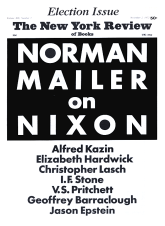In response to:
Will the War Go on Until 1976? from the September 21, 1972 issue
To the Editors:
I am repeatedly amazed, after having written a piece for the New York Times, to frequently hear the tortured analyses of some foreign diplomats, American bureaucrats and ex-bureaucrats, and occasionally commentators on the supposed motives of the source(s) of the story and even of the reporter. More often than not, they remind me of the committee of blind men describing the whole elephant on the basis of the small part each has himself touched.
I.F. Stone is entitled to his views on the future of Vietnam (“Will the War Go on until 1976?” NYR, September 21). But he is not entitled to get away with accusing me of “burying” a story because I allegedly “disapproved of the maverick views” aired by a senior Air Force official in an evening’s conversation with a group of reporters.
Stone ascribes this reasoning to “some colleagues” who were present that evening (and whom, presumably, he talked with on the phone). Pity Stone was neither professional enough nor enterprising enough to have phoned me and asked why I chose, in a story written the following day (after considerable follow-up reporting which none of the other stories reflected), to lead not as several others had done with an estimate of supplies getting into North Vietnam, but with the fact that US planes were bombing within the self-imposed twenty-five-mile buffer zone along the China border and had, on at least one occasion, caused Chinese jets to be scrambled for a possible intercept. (The story was “buried” on page one.)
In advance of coming for cocktails and dinner with a “high Air Force official” I was informed the evening would be entirely social.
Again and again during three and a half hours of conversation, the official kept complaining he was, despite his lofty title, out of the main stream of policy making and frequently unaware of what was happening and why.
Three hours into the evening the official suggested, in answer to a question, that North Vietnam was then getting about 50 percent of the supplies it received prior to the mining of its ports and heavy bombing of its railways and roads. When questioned immediately on this, he said this was not based on intelligence reports and maybe 25 percent would be a better guesstimate.
I had just returned from two weeks of vacation, but just before leaving had done some checking on efforts to increase the flow of war materiel into North Vietnam. I was skeptical of the official’s offhand estimates, in part because they were so much higher than I had heard two weeks earlier, in part because of his own repeated insistence he was too often in the dark as to precisely what was going on.
I was determined, the next working day, to check into his remarks about supplies. Also into his comment that the Air Force had done some bombing within the China buffer, after getting special permission from Washington. And, finally, into his response to a question whether the US might still be bombing the supply lines a few years hence since the South Vietnamese Air Force wasn’t being given that capability, his answer that yes, that was possible, though there were too many unknowns to make a solid prediction.
The official left at about 11:30 P.M. I left promptly thereafter, assuming the session was “off the record” in terms of writing a story, but worthwhile as a basis for checking further into some of his remarks.
A handful of reporters, I was later informed, cornered the host and asked whether stories might be written directly from the discussion. Yes, they were told, so long as the source was not specifically identified except as “high Air Force officials.”
At least three stories—by AP, UPI, and the Washington Star-News—were written right away, without any further checking (since there was no time and the story was competitive).
After considerable reporting the next day, I got some notion of the disparity of analyses (“We don’t know precisely how many freight cars and trucks are coming into the buffer from China, much less how much of what is in those that do come across,” was a typical comment). However, I did get some specific tonnage estimates, suggesting a possible rise to from 12 to 25 percent of previous import levels. I also learned a lot more about bombing in the buffer zone, which, to my knowledge, had not before been written in any detail, and certainly not in the context of the off-limits buffer zone.
I discussed the two different elements of the story with an editor and suggested the buffer zone bombing was more solid than the varying estimates on supplies and thus should lead the story, which would include exclusive details on both. The editor agreed.
Now, if that is “burying” a story because of disapproval of an official’s “maverick” views, then the elephant does indeed look like the trunk of a tree, or like a piece of rope with a frayed end, or like a giant firehose with a wrinkled surface….
William Beecher
The New York Times, Washington Bureau
This Issue
November 2, 1972



